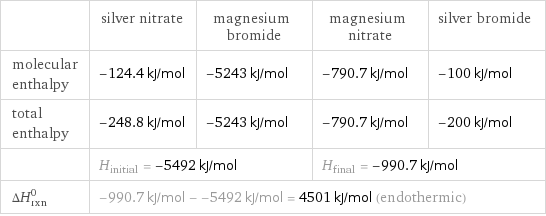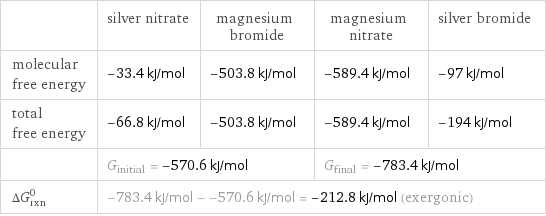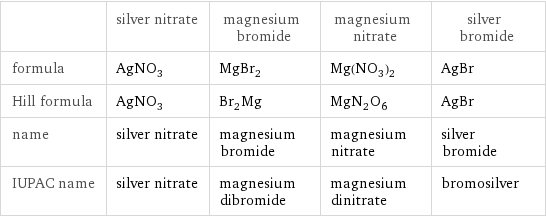Input interpretation

AgNO_3 silver nitrate + MgBr_2 magnesium bromide ⟶ Mg(NO_3)_2 magnesium nitrate + AgBr silver bromide
Balanced equation

Balance the chemical equation algebraically: AgNO_3 + MgBr_2 ⟶ Mg(NO_3)_2 + AgBr Add stoichiometric coefficients, c_i, to the reactants and products: c_1 AgNO_3 + c_2 MgBr_2 ⟶ c_3 Mg(NO_3)_2 + c_4 AgBr Set the number of atoms in the reactants equal to the number of atoms in the products for Ag, N, O, Br and Mg: Ag: | c_1 = c_4 N: | c_1 = 2 c_3 O: | 3 c_1 = 6 c_3 Br: | 2 c_2 = c_4 Mg: | c_2 = c_3 Since the coefficients are relative quantities and underdetermined, choose a coefficient to set arbitrarily. To keep the coefficients small, the arbitrary value is ordinarily one. For instance, set c_2 = 1 and solve the system of equations for the remaining coefficients: c_1 = 2 c_2 = 1 c_3 = 1 c_4 = 2 Substitute the coefficients into the chemical reaction to obtain the balanced equation: Answer: | | 2 AgNO_3 + MgBr_2 ⟶ Mg(NO_3)_2 + 2 AgBr
Structures

+ ⟶ +
Names

silver nitrate + magnesium bromide ⟶ magnesium nitrate + silver bromide
Reaction thermodynamics
Enthalpy

| silver nitrate | magnesium bromide | magnesium nitrate | silver bromide molecular enthalpy | -124.4 kJ/mol | -5243 kJ/mol | -790.7 kJ/mol | -100 kJ/mol total enthalpy | -248.8 kJ/mol | -5243 kJ/mol | -790.7 kJ/mol | -200 kJ/mol | H_initial = -5492 kJ/mol | | H_final = -990.7 kJ/mol | ΔH_rxn^0 | -990.7 kJ/mol - -5492 kJ/mol = 4501 kJ/mol (endothermic) | | |
Gibbs free energy

| silver nitrate | magnesium bromide | magnesium nitrate | silver bromide molecular free energy | -33.4 kJ/mol | -503.8 kJ/mol | -589.4 kJ/mol | -97 kJ/mol total free energy | -66.8 kJ/mol | -503.8 kJ/mol | -589.4 kJ/mol | -194 kJ/mol | G_initial = -570.6 kJ/mol | | G_final = -783.4 kJ/mol | ΔG_rxn^0 | -783.4 kJ/mol - -570.6 kJ/mol = -212.8 kJ/mol (exergonic) | | |
Equilibrium constant
![Construct the equilibrium constant, K, expression for: AgNO_3 + MgBr_2 ⟶ Mg(NO_3)_2 + AgBr Plan: • Balance the chemical equation. • Determine the stoichiometric numbers. • Assemble the activity expression for each chemical species. • Use the activity expressions to build the equilibrium constant expression. Write the balanced chemical equation: 2 AgNO_3 + MgBr_2 ⟶ Mg(NO_3)_2 + 2 AgBr Assign stoichiometric numbers, ν_i, using the stoichiometric coefficients, c_i, from the balanced chemical equation in the following manner: ν_i = -c_i for reactants and ν_i = c_i for products: chemical species | c_i | ν_i AgNO_3 | 2 | -2 MgBr_2 | 1 | -1 Mg(NO_3)_2 | 1 | 1 AgBr | 2 | 2 Assemble the activity expressions accounting for the state of matter and ν_i: chemical species | c_i | ν_i | activity expression AgNO_3 | 2 | -2 | ([AgNO3])^(-2) MgBr_2 | 1 | -1 | ([MgBr2])^(-1) Mg(NO_3)_2 | 1 | 1 | [Mg(NO3)2] AgBr | 2 | 2 | ([AgBr])^2 The equilibrium constant symbol in the concentration basis is: K_c Mulitply the activity expressions to arrive at the K_c expression: Answer: | | K_c = ([AgNO3])^(-2) ([MgBr2])^(-1) [Mg(NO3)2] ([AgBr])^2 = ([Mg(NO3)2] ([AgBr])^2)/(([AgNO3])^2 [MgBr2])](../image_source/d1330e905856db275b7da3f7c15d0995.png)
Construct the equilibrium constant, K, expression for: AgNO_3 + MgBr_2 ⟶ Mg(NO_3)_2 + AgBr Plan: • Balance the chemical equation. • Determine the stoichiometric numbers. • Assemble the activity expression for each chemical species. • Use the activity expressions to build the equilibrium constant expression. Write the balanced chemical equation: 2 AgNO_3 + MgBr_2 ⟶ Mg(NO_3)_2 + 2 AgBr Assign stoichiometric numbers, ν_i, using the stoichiometric coefficients, c_i, from the balanced chemical equation in the following manner: ν_i = -c_i for reactants and ν_i = c_i for products: chemical species | c_i | ν_i AgNO_3 | 2 | -2 MgBr_2 | 1 | -1 Mg(NO_3)_2 | 1 | 1 AgBr | 2 | 2 Assemble the activity expressions accounting for the state of matter and ν_i: chemical species | c_i | ν_i | activity expression AgNO_3 | 2 | -2 | ([AgNO3])^(-2) MgBr_2 | 1 | -1 | ([MgBr2])^(-1) Mg(NO_3)_2 | 1 | 1 | [Mg(NO3)2] AgBr | 2 | 2 | ([AgBr])^2 The equilibrium constant symbol in the concentration basis is: K_c Mulitply the activity expressions to arrive at the K_c expression: Answer: | | K_c = ([AgNO3])^(-2) ([MgBr2])^(-1) [Mg(NO3)2] ([AgBr])^2 = ([Mg(NO3)2] ([AgBr])^2)/(([AgNO3])^2 [MgBr2])
Rate of reaction
![Construct the rate of reaction expression for: AgNO_3 + MgBr_2 ⟶ Mg(NO_3)_2 + AgBr Plan: • Balance the chemical equation. • Determine the stoichiometric numbers. • Assemble the rate term for each chemical species. • Write the rate of reaction expression. Write the balanced chemical equation: 2 AgNO_3 + MgBr_2 ⟶ Mg(NO_3)_2 + 2 AgBr Assign stoichiometric numbers, ν_i, using the stoichiometric coefficients, c_i, from the balanced chemical equation in the following manner: ν_i = -c_i for reactants and ν_i = c_i for products: chemical species | c_i | ν_i AgNO_3 | 2 | -2 MgBr_2 | 1 | -1 Mg(NO_3)_2 | 1 | 1 AgBr | 2 | 2 The rate term for each chemical species, B_i, is 1/ν_i(Δ[B_i])/(Δt) where [B_i] is the amount concentration and t is time: chemical species | c_i | ν_i | rate term AgNO_3 | 2 | -2 | -1/2 (Δ[AgNO3])/(Δt) MgBr_2 | 1 | -1 | -(Δ[MgBr2])/(Δt) Mg(NO_3)_2 | 1 | 1 | (Δ[Mg(NO3)2])/(Δt) AgBr | 2 | 2 | 1/2 (Δ[AgBr])/(Δt) (for infinitesimal rate of change, replace Δ with d) Set the rate terms equal to each other to arrive at the rate expression: Answer: | | rate = -1/2 (Δ[AgNO3])/(Δt) = -(Δ[MgBr2])/(Δt) = (Δ[Mg(NO3)2])/(Δt) = 1/2 (Δ[AgBr])/(Δt) (assuming constant volume and no accumulation of intermediates or side products)](../image_source/987fe78ad86c5a3e9e92ce7d1afed969.png)
Construct the rate of reaction expression for: AgNO_3 + MgBr_2 ⟶ Mg(NO_3)_2 + AgBr Plan: • Balance the chemical equation. • Determine the stoichiometric numbers. • Assemble the rate term for each chemical species. • Write the rate of reaction expression. Write the balanced chemical equation: 2 AgNO_3 + MgBr_2 ⟶ Mg(NO_3)_2 + 2 AgBr Assign stoichiometric numbers, ν_i, using the stoichiometric coefficients, c_i, from the balanced chemical equation in the following manner: ν_i = -c_i for reactants and ν_i = c_i for products: chemical species | c_i | ν_i AgNO_3 | 2 | -2 MgBr_2 | 1 | -1 Mg(NO_3)_2 | 1 | 1 AgBr | 2 | 2 The rate term for each chemical species, B_i, is 1/ν_i(Δ[B_i])/(Δt) where [B_i] is the amount concentration and t is time: chemical species | c_i | ν_i | rate term AgNO_3 | 2 | -2 | -1/2 (Δ[AgNO3])/(Δt) MgBr_2 | 1 | -1 | -(Δ[MgBr2])/(Δt) Mg(NO_3)_2 | 1 | 1 | (Δ[Mg(NO3)2])/(Δt) AgBr | 2 | 2 | 1/2 (Δ[AgBr])/(Δt) (for infinitesimal rate of change, replace Δ with d) Set the rate terms equal to each other to arrive at the rate expression: Answer: | | rate = -1/2 (Δ[AgNO3])/(Δt) = -(Δ[MgBr2])/(Δt) = (Δ[Mg(NO3)2])/(Δt) = 1/2 (Δ[AgBr])/(Δt) (assuming constant volume and no accumulation of intermediates or side products)
Chemical names and formulas

| silver nitrate | magnesium bromide | magnesium nitrate | silver bromide formula | AgNO_3 | MgBr_2 | Mg(NO_3)_2 | AgBr Hill formula | AgNO_3 | Br_2Mg | MgN_2O_6 | AgBr name | silver nitrate | magnesium bromide | magnesium nitrate | silver bromide IUPAC name | silver nitrate | magnesium dibromide | magnesium dinitrate | bromosilver
Substance properties

| silver nitrate | magnesium bromide | magnesium nitrate | silver bromide molar mass | 169.87 g/mol | 184.11 g/mol | 148.31 g/mol | 187.77 g/mol phase | solid (at STP) | solid (at STP) | solid (at STP) | solid (at STP) melting point | 212 °C | 711 °C | 88.9 °C | 432 °C boiling point | | | 330 °C | 1300 °C density | | 3.72 g/cm^3 | 1.2051 g/cm^3 | 6.473 g/cm^3 solubility in water | soluble | soluble | | insoluble odor | odorless | | |
Units
